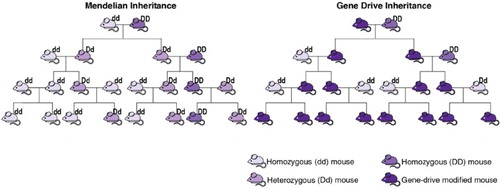Figures & data
Figure 1. An idealized illustration of mendelian inheritance versus gene drive inheritance. Gene drives are often described as an exception to the conventional rules of inheritance first described in 1866 by a monk named Gregor Mendel. Under Mendelian inheritance (left), offspring have a 50% chance of inheriting a gene (d or D). With a gene drive (right), the offspring will almost always receive the targeted genetic element (shown in dark purple), the end results of which is the preferential increase of a specific genotype. The different shades of purple correspond to the different mouse genotypes (dd, Dd, DD, or gene drive). In this idealized illustration, the targeted genetic element is eventually present in 100% of the population, although this may not always occur. The number of generations and amount of time for a selfish genetic element (DNA sequences where inheritance is biased in their favor) to spread throughout a population will vary depending on the drive mechanism, the species, and a variety of environmental conditions.

